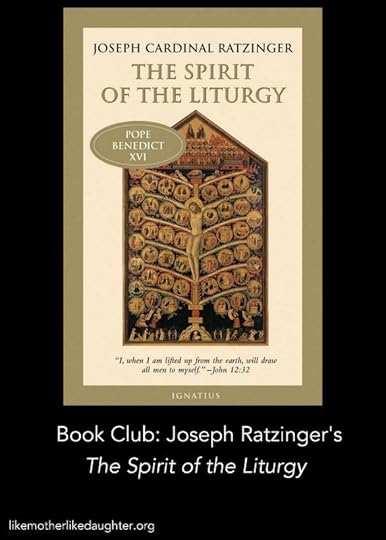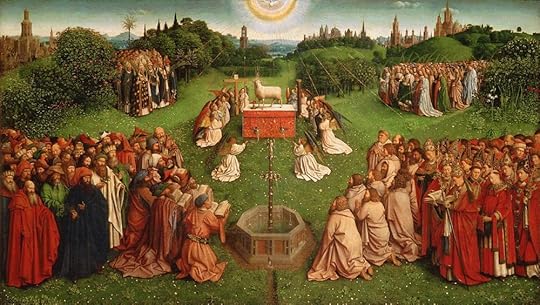Is the Eucharist for eating or for looking at? ~ The Spirit of the Liturgy, A Book Club

{Book Club: The Spirit of the Liturgy}
I hope you will read along in this book club (or just read my posts, that’s okay): Joseph Ratzinger’s The Spirit of the Liturgy.
(When you buy something via our Amazon affiliate link, a little cash rolls our way… just a little. Thanks!)
I’ll post on Fridays, although for this longer book, perhaps not every Friday. I’ll give you your homework, I’ll talk about what we read, we’ll discuss in the comments. Even if you read later, the comments will still be open.
Previously:
Introduction to the reading: Joseph Ratzinger’s The Spirit of the Liturgy: A Book Club for Easter and Beyond
Nature or history in worship? Or both?
The Relationship of the Liturgy to Time and Space: preliminary questions
Homework: Read Chapter Five of Part II.
Chapter Four, Part II: The Reservation of the Blessed Sacrament
Do you notice that as soon as I start posting about orientation, Cardinal Robert Sarah, the prefect of the Congregation for Divine Worship and the Sacraments, calls for the ad orientem posture at Mass? I don’t like to brag, but yeah, I pretty much control the agenda over there. Dear Cardinal Sarah calls me up before breakfast just to know what’s up for the day’s activities and liturgical inquiries.
And I’m sure that like me, you have noticed how the discussion surrounding this and other liturgical issues lacks depth of study and serves mainly to increase the perception that matters of worship have to do with preference.
If only people (or at least those who profess to be the experts in these matters) would read the two books we’ve been studying, they’d be better off. They’d know the answers to their questions and the responses to their arguments.
But let’s us study, anyway!
Recently the Chief and I were in Italy and France. We entered countless churches, both humble and grand. In each one, we felt the enveloping Presence, we knew we were in a sanctuary. Then we went to London. Our first visit was to Westminster Cathedral; again, the sense of home, of life. One day we had a tour of the Tower of London, which ended with a visit to the chapel. It’s a lovely structure of course, a charming medieval stone building. But its only claim to sanctity is the fact of the souls (and at least one saint) buried there. As a place to worship, it is empty.
This week’s chapter concerns just this, the Blessed Sacrament. To our friends here of no faith, or even to our Protestant friends, this is going to be something so foreign, it’s hard to figure out what is being talked about. To our Catholic friends, it’s likely to be a no-brainer — of course we adore! So I’m going to try to sort it out quickly and efficiently, as one does.
Every question comes back to this one: What is worship? Are things we do fitting? And fitting to what? Our likes and dislikes? Reality? Scripture? History? Are practices like adoration strange add-ons that ought to be cut away? Was there a period of time (obviously the Middle Ages) where practices sprang up due to the iron grip of a venal clergy on a superstitious and unsuspecting flock?
Ratzinger starts the chapter with the reality of the Real Presence:
It is plain for all to see that already for St. Paul bread and wine become the Body and Blood of Christ, that it is the risen Lord himself who is present and gives himself to us to eat. The vigor with which the Real Presence is emphasized in John chapter 6 could hardly be surpassed. For the Church Fathers, too, from the earliest witnesses onward — just think of St. Justin Martyr or St. Ignatius of Antioch — there is no doubt about the great mystery of the Presence bestowed upon us, about the change of the gifts [bread and wine] during the Eucharistic Prayer. Even a theologian of such a spiritualizing tendency as St. Augustine never had a doubt about it.” (P. 86)
The True Body of Christ is the means by which his people become the True Body of the Church, his body. “Only the true Body in the Sacrament can build up the true Body of the new City of God.” Thus, there was no “period of decadence” in which meaning got corrupted. It was always and continues to be the actual transubstantiated species — Body and Blood, Soul and Divinity, True Christ — which brings our transformation about.
And this species, called the Host, the Blessed Sacrament, the Eucharist (a word that applies both to the event in which the substance is confected, and the substance itself) — “once changed, remains changed.”
Here is another “escape from preference”: because of our habit of thinking of religion in terms of our heart and how we feel about things, we can lapse into considering external realities as dependent on how we are thinking about them.
It’s so good for us to be reminded that the whole universe is out there, going on its way regardless of the attention we pay to it. And Our Lord remains present in the Host, which has the appearances of bread, as long as it continues with those appearances (or “accidents” as the philosophers call them). If the bread decays, then the Presence is no longer there. When our bodies break the bread down and digest it, the Presence is not there, although God remains with us — just not bodily.
By the way, this fact is another example of Ratzinger’s exitus and reditus — exiting and returning. He comes to us in the Host, we incorporate him, and he leaves — but he sends His Spirit. When we have communicated at Mass, we become the vehicle for this “leaving-returning” — the Spirit animates us. That is why Jesus told us to have no fear for what we will say. He sends his Spirit.
Anyway, the early Christians knew this. “That is why they reserved [the Host] for the sick.” And when they reserved the Sacrament, they knew it had to have a fitting place. This is how the tabernacle came to be. And yes, the Presence there in the Church changed things.
This realization came upon the Middle Ages with a wholly new intensity. It was caused in part by the deepening of theological reflection, but still more important was the new experience of the saints [that is, the ordinary faithful, not only professional thinkers], especially in the Franciscan movement and in the new evangelization undertaken by the Order of Preachers [Dominicans]… a new dimension… in complete continuity with what had always been believed hitherto…. This deepened awareness of faith is impelled by the knowledge that in the consecrated species he is there and remains there… when a man experiences this with every fiber of his heart and mind and sense, the consequence is inescapable: “We must make a proper place for this Presence.” (P. 89)
In Pilgrim Fellowship of Faith, Ratzinger makes it clear that it is not the gathering of the community as such that makes the Church, or even “a loose federation” of such communities. “She does not become one through a centralist form of government; instead, one common center for us all is possible because she is always derived from the one Lord, who in the one bread makes her to be one body. That is why her unity goes deeper than any human union could ever go.” The Church is the union of persons in Christ’s body… but stop thinking of this in a vague, metaphorical way! In. His. Body. That we eat.
Eating the Body and Blood of Jesus, as he commanded, is worshipping.
Eating it means letting it come into me, so that my “I” is transformed and opens up in to the great “we”, so that we become “one” in him (cf. Gal 3:16). (P. 90)
So the Sacrament is what it is, it doesn’t change — it must be reserved. There must be a tabernacle.
What then is Adoration?

In a homily, Ratzinger says this:
… this idea of assembly had become flattened and separated from the idea of sacrifice, and thus the Eucharist had shrunk to a mere sign of brotherly fellowship. At the same time the concentration of the eucharistic celebration was causing faith and sacrament to lose something of their place among us. This has become quite visible in many churches — the place of adoration hides away somewhere on the edge of things, like a bit of the past. What was more far-reaching was the way the Eucharist itself was shrinking to the space of a brief half-hour, so that it could no longer breathe life into the building, no longer the be the pulse of time. Confined to the space of the sacred rite, it was becoming a tiny island of time on the edge of the day, which as a whole was given over to the profane and hectic business of our worldly activity. [Now] we realize that the adoration of the Sacrament was not in competition with the living celebration of the community, but its condition, its indispensable environment. Only within the breathing space of adoration can the eucharistic celebration indeed be alive; only if the church and thus the whole congregation is constantly imbued with the waiting presence of the Lord, and with our silent readiness to respond, can the invitation to come together bring us in to the hospitality of Jesus Christ and of the Church, which is the precondition of the invitation.
When we have a place for the Presence, when we set aside time for the Presence, then we have the preconditions for receiving (eating) the Presence. “A person cannot communicate with another person without knowing him.” (From God is Near Us.)
Ratzinger has a stark observation:
[With the Sacrament reserved in the Tabernacle], the church never becomes a lifeless space but is always filled with the presence of the Lord, which comes out of the celebration, leads us into it, and always makes us participants in the cosmic Eucharist. What man of faith has not experienced this? A church without the Eucharistic Presence is somehow dead…
Permit me to end with two stories which put this statement in a positive way — which show that a church with the Eucharistic Presence is somehow alive.
The first is the story of André Frossard, journalist, man of secular France in the 20th century. An atheist, whose only relationship with religion was one of ironic detachment, he was waiting for a friend outside a chapel where some nuns were adoring Jesus in the Blessed Sacrament (that is, the Host — the bread that has been transformed into the Body of Christ — is placed in a stand on the altar for people to pray before).
He got impatient for his friend and went inside. He writes of his conversion:
I still see him, the twenty years old boy I was then, I have not forgotten the wonder that seized him when, from the depths of the chapel, of no particular beauty, suddenly saw the rise of a world in front of him, another world of unbearable splendor, crazy density, whose light revealed and concealed at the same time the presence of God, the God who, a moment before, he would have sworn, had never existed except in the imagination of men; at the same time he was submerged by a wave, which was rampant with joy and sweetness, a flood whose power broke his heart and that he never forgot, even in the darkest moments of a life invested, more than once, by horror and by misfortune; he had no other task, since then, than to bear witness to this sweetness and this heartbreaking purity of God who, that day, showed him of what kind of mud he was made.
He had a sense of humor. “I was as surprised,” he wrote, “to find myself a Catholic when I left the chapel as I would have been to find myself a giraffe when I left the zoo.” He also said, “Sometimes to me it happens to get out of a station without becoming a train. As for my own free will, I can claim to have it only after my conversion, when I realized that only God could save us from all forms of enslavement in which, without him, we would surely be doomed to.”
The other story is of Sweden’s Ulf Ekman, formerly Evangelical pastor of one of the world’s largest congregations. His story is a fascinating one and has many elements, of course, but striking to me was this statement which I translate from a French interview:
I became Catholic first of all because of a spiritual experience. At the end of the 90s, when I was working in Hawaii, I went “by mistake” into a Catholic chapel that had Eucharistic Adoration. I sat down. I sensed that the Christ was really present. This impression never left me. Thereafter, I felt the need, as pastor, to restore the liturgy and the sacraments within my church.
Ultimately, he did enter the Catholic church.
We need the Presence in our churches.
Were there any other passages you’d like to talk about?
Questions? Comments? I’d love to hear from you!
(Emphases added in quotes are mine.)
Click here to see our previous discussion of Romano Guardini’s The Spirit of the Liturgy, which you can read free, online. You can also purchase it here, although be warned, this edition does not have the footnotes, which stinks .
.
The post Is the Eucharist for eating or for looking at? ~ The Spirit of the Liturgy, A Book Club appeared first on Like Mother Like Daughter.



